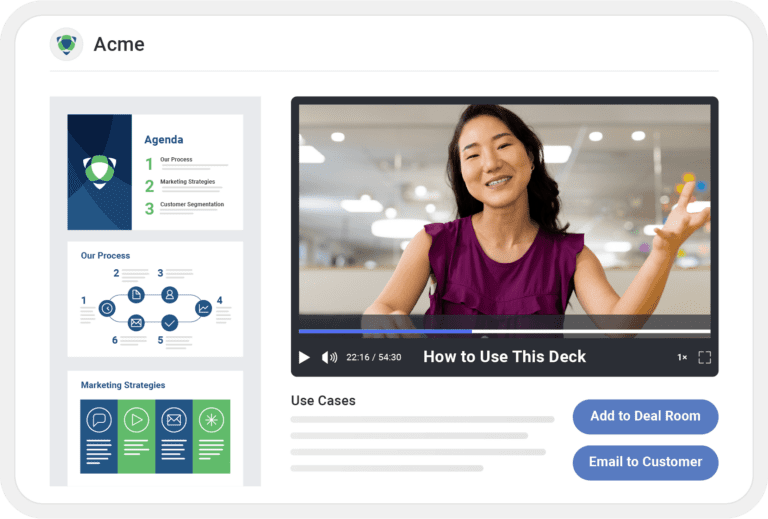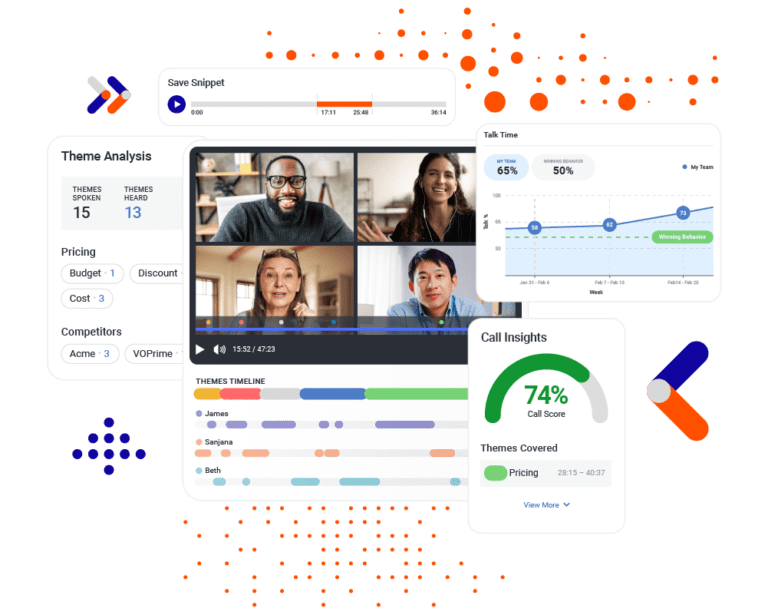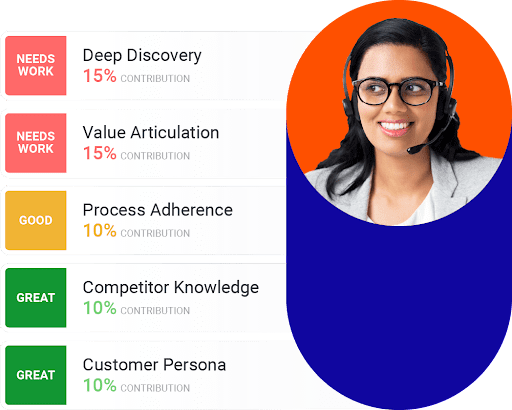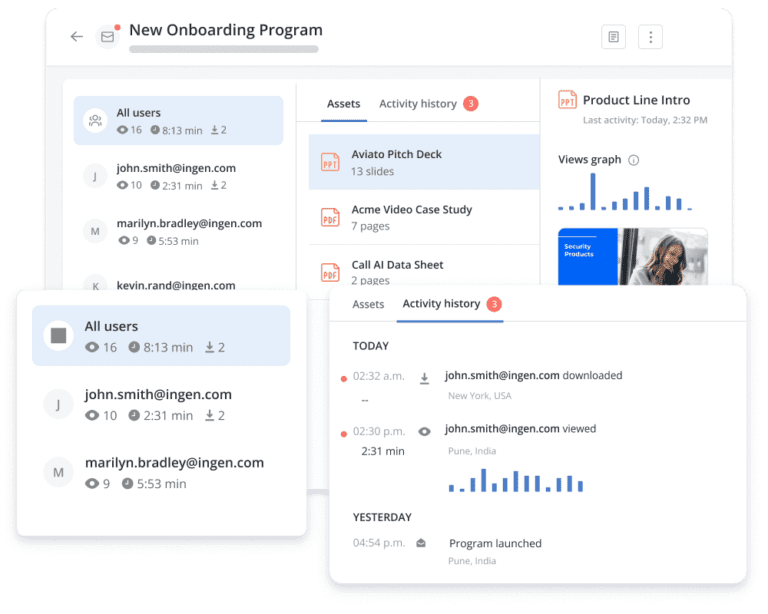In an ideal world, each of your sales reps would be as productive as possible and crush quota every quarter. But more often than not, that’s not the case.
A survey fielded last year found that the majority – 72% – of sellers didn’t expect to hit their quotas for the year. What gives?
While quota attainment and sales productivity might slip for any number of reasons, there are some that are more common than others. Read on to explore seven of the top reasons your quota attainment and sales productivity are slipping – and what you can do to turn things around.
- Reason #1: You’re only focused on onboarding
- Reason #2: Your reps can’t find the content they need — or they don’t even know it exists
- Reason #4: You’re taking an ad hoc approach to sales coaching
- Reason #5: You’re using the wrong metrics to measure revenue enablement success (or not measuring at all)
- Reason #6: Your training program is all over the place
- Reason #7: You’re using point solutions that focus on a single piece of the enablement puzzle
What is a sales quota and why is it important?
A sales quota is the sales performance target sellers must achieve during a certain time period, usually a quarter.
When a seller achieves their quota, they’ll also receive their incentive target pay. Sales quotas are set by sales leaders and are an incentive for sellers to perform. Sales enablement teams work closely with sales leadership to monitor quota attainment to ensure enablement efforts are focused on helping every seller meet and beat their quota each quarter.
Reason #1: You’re only focused on onboarding
Often, sales organizations invest a lot of time and resources into developing a great onboarding program. And that’s certainly not a bad thing. A solid onboarding program can serve as a great foundation for sellers’ success, familiarizing them with the company, its products, goals, and how sellers will play a role in achieving those goals. What’s more, great onboarding is proven to get you closer to your revenue goals.
According to the 2024 State of Revenue Productivity Report, sellers at winning organizations take an onboarding program on average 21-23 days to complete, a significant decrease from the prior year.
Sellers take an average of
But the thing is, new reps are bombarded with information during onboarding — and unlikely to retain it all. In fact, research from Ardent Learning shows that the most significant loss of knowledge happens within the first day and within three months, most people have forgotten between 84% and 90% of the information they learned during training.
Instead, organizations must also incorporate continuous learning (what we refer to as sales everboarding) if they expect reps to absorb and retain information — and then apply that information in the field. Our research with Heinz Marketing found that 78.6% of companies that have an effective training program meet 100% of their selling quota. And 90% who hit 75% or more of their quota participate in sales training on a monthly basis. If you’re not there already, now’s the time to transition from onboarding to sales everboarding.
Reason #2: Your reps can’t find the content they need — or they don’t even know it exists
We’ve all heard the adage that content is king. For revenue organizations, this sentiment is certainly true. Sales content—both internal and external—plays a key role in selling success.
Most organizations understand the importance of content and devote time to creating plenty of it. This normally includes internal content (such as a just-in-time training piece or a recording of a top seller delivering their sales pitch) and external content (such as pitch decks and sell sheets).
The goal of content is to ensure sellers are always ready and have what they need to move deals forward. But even the greatest content is completely useless if a rep doesn’t know where to find it or that it even exists. And this happens… a lot. Our 2024 State of Sales Readiness Report found that just 10% of content generates 50% of all engagement.
The most successful revenue organizations house all internal and external content in a single, easily searchable platform. That way, reps have easy access to the content they need, when they need it, so that they can spend less time hunting for content (or — gasp! — creating their own) and more time moving deals forward and hitting revenue targets.

Reason #3: Your reps don’t know why deals go south
A rep shares the news that they’ve lost a deal they thought was in the bag. You try to dig for more information, but the rep can’t explain why the deal was lost. And that makes it pretty difficult (if not impossible) to coach that rep toward better outcomes in the future.
Of course, frontline managers are busy. They don’t have the time to attend every rep call to understand what’s going right or wrong.
But the good news is that conversation intelligence solutions, such as Mindtickle’s Call AI, allow managers to understand what’s really happening in the field. With conversation intelligence, sales managers can identify competency and knowledge gaps that might be standing in the way of a seller closing more deals — and then work to deliver coaching that’ll diminish those gaps and empower the rep to close more deals.


Reason #4: You’re taking an ad hoc approach to sales coaching
Sales coaching — when it’s done well — can have a tremendous impact on rep productivity and quota attainment. Research tells us eight out of 10 teams with effective coaching practices hit over 75% of sales quotas.
But sales coaching is often not done well. There’s often no top-down agreement on coaching goals and methods. Instead, frontline managers are left to their own devices to coach as they see fit. This means many of them take an ad hoc approach that involves purely tactical efforts like deal reviews, and they don’t have the time, sales coaching tools, or training needed for effective coaching.
Ad hoc coaching isn’t effective. In fact, it’s downright counterproductive. Research from CSO Insights shows that 75% of sales organizations waste resources due to random and informal coaching approaches.
Instead, an organization must build a culture of coaching if it expects to see improvements in quota attainment and productivity. This has to start from the top, with the chief revenue officer.
But how?
Start by defining what you hope to achieve by building a coaching culture. Then, there must be alignment on a standard coaching approach that will help you achieve those goals.
In addition, for coaching to be effective, it must be individualized for each rep. Organizations should first define their ideal rep profile (IRP).


This is the set of skills and competencies a given rep must have to succeed at the organization. With the IRP in place, it’s easier for managers to identify skill gaps — and then provide personalized sales coaching to address those gaps.
Reason #5: You’re using the wrong metrics to measure enablement (or not measuring at all)
The same CSO Insights report mentioned earlier found that a mere 24% of enablement teams are able to measure the ROI of their programs. That’s a big problem. Without consistent measurement, you can’t understand how your sales enablement efforts impact sales performance — and how to optimize programs for better results.
A lot of organizations say they measure impact. But often this involves tracking metrics like adoption and engagement. Sure, usage data matters — but it only tells a small part of the story. A rep might consume all the training assigned to them, yet continue to miss quota every quarter.
Instead, organizations must regularly track a wide range of data on sales performance to understand how their programs are impacting productivity and quota attainment. Of course, these metrics vary from organization to organization, but all should track some core metrics. For example, organizations can (and should) track each individual’s performance against the company’s ideal rep profile. They should also leverage data from sales conversations to measure how training is (or isn’t) applied in the field.
The right technology equips sales leaders with the right data at the right time — presented in a way that’s easy to consume and take action on.


Reason #6: Your training program is all over the place
With everything else on your plate, focusing on building out ongoing sales training programs sometimes falls to the wayside. However, there’s a case to be made for making sales training programs a priority project in the year ahead. Our research with Heinz Marketing found that 78.6% of companies with an effective program meet 100% of their selling quota. Outside of that, organizations have seen improved seller engagement and retention. To build a sales training program that works, make sure you’re:
- Going beyond onboarding
- Defining what good looks like
- Making it personal
- Reinforcing it
- Mixing up the format
- Measuring the impact
Reason #7: You’re using point solutions that focus on a single piece of the revenue enablement puzzle
The revenue technology landscape is complicated. Hundreds of vendors promise their solutions will improve sales productivity and quota attainment.
Some of these vendors may even bill their wares as revenue productivity or revenue enablement solutions. But in reality, these offerings only address a single component of true revenue enablement, such as training or content. On their own, they’re not enough to improve quota attainment and productivity. And investing in multiple solutions is expensive and complicated.
They often don’t play well together and require your reps to learn and use several technologies.
To truly increase quota attainment and sales productivity (and achieve revenue enablement success), sales leaders must be able to:
- Define excellence
- Build the knowledge their reps need to close deals
- Equip sellers with content aligned to the sales process
- Analyze what’s happening in the field
- Optimize reps’ behaviors to improve outcomes
While you may have invested in products that address one of these, the most successful sales teams are those that use a solution that addresses them all — within a single revenue enablement platform.
Crush quota every quarter with Mindtickle
For many organizations, missed sales quotas have become the norm. But it doesn’t have to be that way.
Now’s the time to streamline your tech stack by trading point solutions for an integrated revenue enablement platform like Mindtickle.
With Mindtickle, sellers can access the training, coaching, tools, and content they need to learn, practice, and perfect their skills – all within a single, integrated revenue enablement platform. Plus, sales and enablement leaders can measure the impact of their efforts and optimize accordingly.
Crush quota every quarter
See how Mindtickle gets your reps more productive faster and measures the success of your enablement efforts.
Get a DemoThis post was originally published in January 2022, and was updated in January 2023, October 2023, and July 2024.







